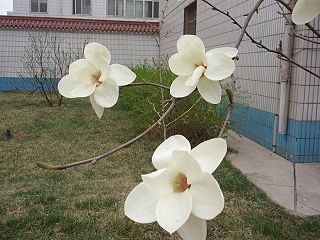Related Research Articles

Bromeliales is an order of flowering plants. Such an order has been recognized by a few systems of plant taxonomy, with a various placement. It appears that it always has had the same circumscription: consisting only of the family Bromeliaceae, the bromeliad or pineapple family. The order is not recognized in the APG II system, of 2003, which places the plants involved in the order Poales. Some examples are:

Liliales is an order of monocotyledonous flowering plants in the Angiosperm Phylogeny Group and Angiosperm Phylogeny Web system, within the lilioid monocots. This order of necessity includes the family Liliaceae. The APG III system (2009) places this order in the monocot clade. In APG III, the family Luzuriagaceae is combined with the family Alstroemeriaceae and the family Petermanniaceae is recognized. Both the order Lililiales and the family Liliaceae have had a widely disputed history, with the circumscription varying greatly from one taxonomist to another. Previous members of this order, which at one stage included most monocots with conspicuous tepals and lacking starch in the endosperm are now distributed over three orders, Liliales, Dioscoreales and Asparagales, using predominantly molecular phylogenetics. The newly delimited Liliales is monophyletic, with ten families. Well known plants from the order include Lilium (lily), tulip, the North American wildflower Trillium, and greenbrier.

The dicotyledons, also known as dicots, are one of the two groups into which all the flowering plants (angiosperms) were formerly divided. The name refers to one of the typical characteristics of the group: namely, that the seed has two embryonic leaves or cotyledons. There are around 200,000 species within this group. The other group of flowering plants were called monocotyledons, typically each having one cotyledon. Historically, these two groups formed the two divisions of the flowering plants.

The Nymphaeales are an order of flowering plants, consisting of three families of aquatic plants, the Hydatellaceae, the Cabombaceae, and the Nymphaeaceae. It is one of the three orders of basal angiosperms, an early-diverging grade of flowering plants. At least 10 morphological characters unite the Nymphaeales. One of the traits is the absence of a vascular cambium, which is required to produce both xylem (wood) and phloem, which therefore are missing. Molecular synapomorphies are also known.
Hydatellales is a botanical name for an order of flowering plants. In the Cronquist system, 1981, the name was used for an order placed in the subclass Commelinidae in class Liliopsida [=monocotyledons]. The order consisted of one family only:

Monocotyledons, commonly referred to as monocots, are grass and grass-like flowering plants (angiosperms), the seeds of which typically contain only one embryonic leaf, or cotyledon. They constitute one of the major groups into which the flowering plants have traditionally been divided; the rest of the flowering plants have two cotyledons and are classified as dicotyledons, or dicots.

Magnoliopsida is a valid botanical name for a class of flowering plants. By definition the class will include the family Magnoliaceae, but its circumscription can otherwise vary, being more inclusive or less inclusive depending upon the classification system being discussed.

LiliopsidaBatsch is a botanical name for the class containing the family Liliaceae. It is considered synonymous with the name monocotyledon. Publication of the name is credited to Scopoli : see author citation (botany). This name is formed by replacing the termination -aceae in the name Liliaceae by the termination -opsida.

Smilacaceae, the greenbriers, is a family of flowering plants. While they were often assigned to a more broadly defined family Liliaceae, most recent botanists have accepted the two as distinct families, diverging around 55 million years ago during the Early Paleogene. One characteristic that distinguishes Smilacaceae from most of the other members of the Liliaceae-like Liliales is that it has true vessels in its conducting tissue. Another is that the veins of the leaves, between major veins, are reticulate (net-shaped), rather than parallel as in most monocots.
The Cronquist system is a taxonomic classification system of flowering plants. It was developed by Arthur Cronquist in a series of monographs and texts, including The Evolution and Classification of Flowering Plants and An Integrated System of Classification of Flowering Plants (1981).

Armen Leonovich Takhtajan or Takhtajian, was a Soviet-Armenian botanist, one of the most important figures in 20th century plant evolution and systematics and biogeography. His other interests included morphology of flowering plants, paleobotany, and the flora of the Caucasus. He was one of the most influential taxonomists of the latter twentieth century.
A system of plant taxonomy, the Thorne system of plant classification was devised by the American botanist Robert F. Thorne (1920–2015) in 1968, and he continued to issue revisions over many years (1968–2007).
One of the modern systems of plant taxonomy, the Dahlgren system was published by monocot specialist Rolf Dahlgren in 1975 and revised in 1977, and 1980. However, he is best known for his two treatises on monocotyledons in 1982 and revised in 1985. His wife Gertrud Dahlgren continued the work after his death.

In plant taxonomy, commelinids is a clade of flowering plants within the monocots, distinguished by having cell walls containing ferulic acid.

Liliidae is a botanical name at the rank of subclass. Circumscription of the subclass will vary with the taxonomic system being used ; the only requirement being that it includes the family Liliaceae.
A 20th-century system of plant taxonomy, the Reveal system of plant classification was drawn up by the American botanist James Reveal (1941-2015). The system was published online in 1997 in ten parts as lecture notes comparing the major systems in use at that time. Subsequently, Reveal became an author with the consensus Angiosperm Phylogeny Group (APG) on the APG II 2003 and APG III 2009 processes. Although this largely supplanted the earlier and competing systems, he collaborated with Robert Thorne on his system (2007), and subsequently continued to develop his own system.

Uvulariaceae is a family of flowering plants. While seldom recognised, the family is accepted by the Dahlgren system, which places it in order Liliales, superorder Lilianae, and the subclass Liliidae [=monocotyledons] of class Magnoliopsida [=angiosperms].

Lilianae is a botanical name for a superorder of flowering plants. Such a superorder of necessity includes the type family Liliaceae. Terminations at the rank of superorder are not standardized by the International Code of Nomenclature for algae, fungi, and plants (ICN), although the suffix -anae has been proposed.

MelanthialesLink was an order of monocotyledons, whose name and botanical authority is derived by typification from the description of the type family, Melanthiaceae by Johann Heinrich Friedrich Link in 1829.

BurmannialesMart. was an order of monocotyledons, subsequently discontinued.
References
- ↑ Takhtajan 1966.
- ↑ Takhtajan 1980.
- 1 2 Singh 2004, pp. 269–277.
- ↑ Takhtajan 1966, p. 51.
- ↑ Takhtajan 2009.
- ↑ Reveal 1998.
- ↑ Reveal 1997.
- ↑ Takhtajan 2009, Synopsis of families pp. xxxvii–xlv.
- ↑ Takhtajan 2009, p. 1.